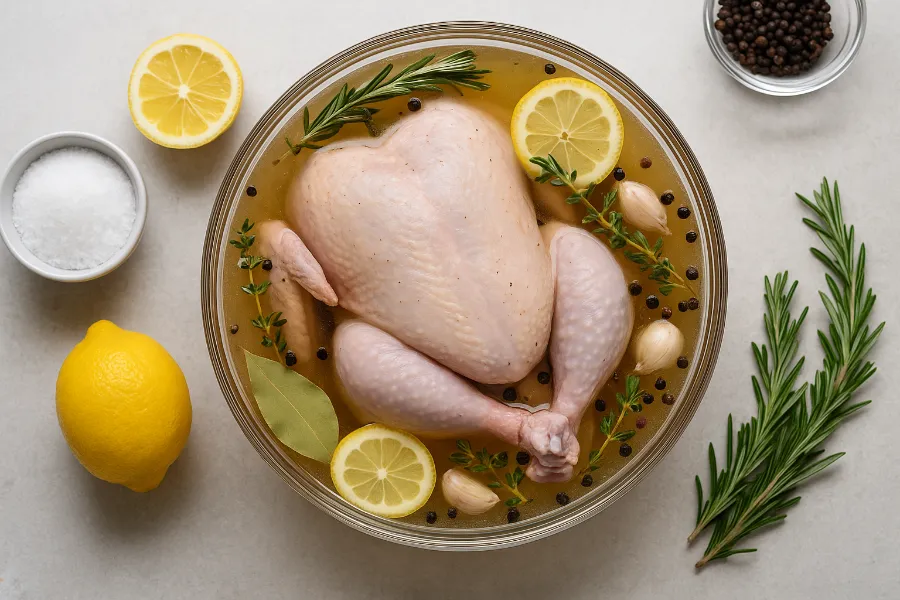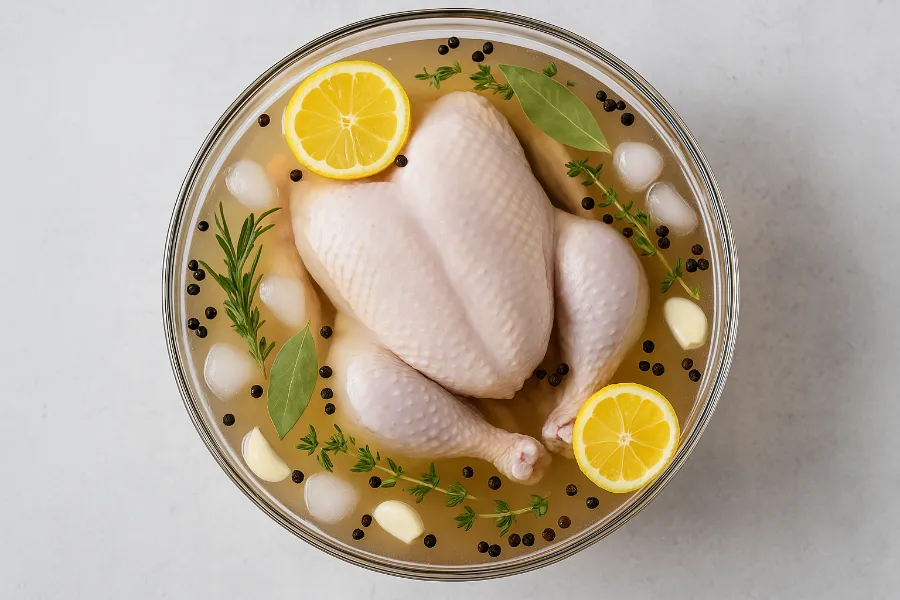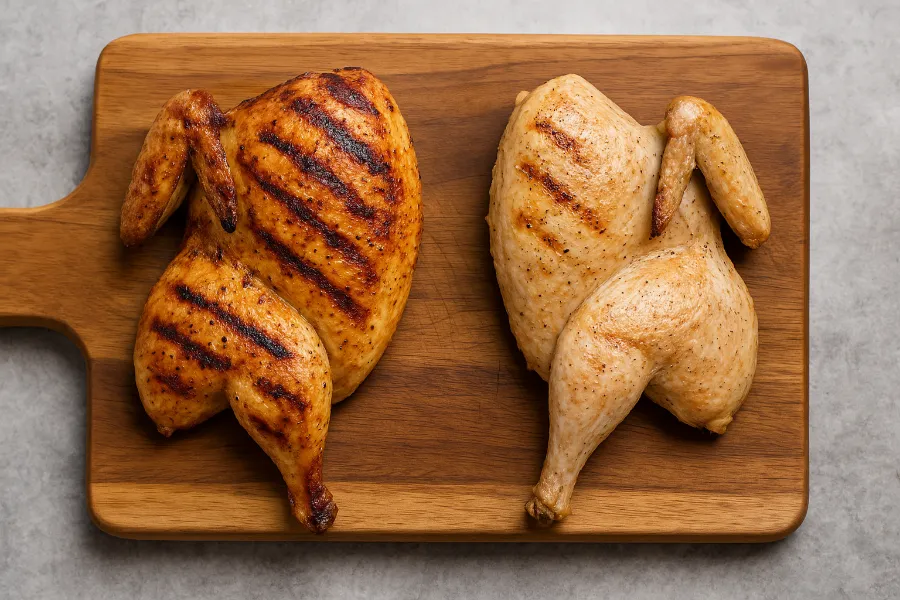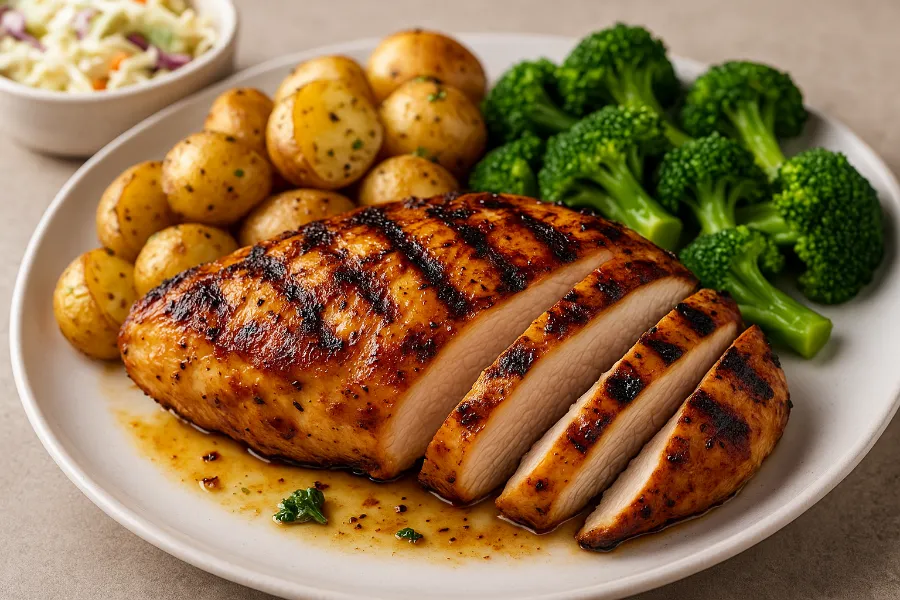Hey there, fellow chicken lover! If you’ve ever wondered how to brine a whole chicken at home so that every bite is juicy, flavorful, and never dry, you’re in the right place. I used to struggle with dry breasts and under-seasoned birds, but once I nailed a consistent simple salt brine chicken technique, roasting or grilling chicken became something I genuinely look forward to. I’m going to walk you through everything—from best salt ratio for chicken brine to timing—so you can feel confident doing it yourself.
Brining a Whole Chicken

Brining a whole chicken is, hands down, one of the best ways to ensure that no part of the bird is left dry or bland. I love doing this for a Sunday roast because it’s a “set it and mostly forget it” affair until roasting time. If you’ve ever wondered how long to brine a chicken before roasting, this section has your answer.
Here’s how I do it:
- Use a clean, non-reactive container (plastic, glass, or stainless steel) large enough so the whole chicken can be completely submerged.
- For a 4- to 5-pound whole chicken: dissolve about ½ cup of kosher salt per quart of water in warm water to make the brine, then add enough cold water/ice to have sufficient depth. Add aromatics—garlic cloves, peppercorns, bay leaves, maybe a halved lemon or two—for a homemade chicken brine for tender meat.
- Let the chicken soak in that brine, refrigerated, for 12 to 24 hours (max).
- After the brine, I rinse lightly and pat dry, and let it rest uncovered in the fridge for a couple hours if possible—that helps dry out the skin so when you roast, it gets beautifully crisp.
Brining the whole bird is slower, but the payoff is worth it. The meat is juicy, the flavor penetrates deeply, and you get that perfect brine for juicy roast chicken recipe every time.
Brine for Roasting Chicken

When I plan to roast a chicken, I want that melt-in-your-mouth texture plus a golden, crisp skin. A proper chicken brine with herbs and garlic helps with both flavor and browning.
What I adjust or include specifically for roasting:
- Add a bit of sugar or maple syrup (just a tablespoon or two) to the brine—this helps with browning the skin and is great if you’re experimenting with sugar in chicken brine for crispy skin.
- Aromatics: rosemary, thyme, smashed garlic, onion, sometimes a little citrus. These add subtle undertones without overpowering the chicken flavor.
- Finish: after brining and drying, rub a little olive oil (or butter under the skin if you want indulgence) and season with black pepper. The outer skin will crisp, the inside stays juicy.
Roasting time: once the brined chicken goes in at a properly preheated oven (around 425°F / 218°C for the first 10-15 minutes, then lower to ~375°F / ~190-200°C), you’ll notice a better skin texture and more even cooking. The brine helps hold moisture even when the breast is done before the thighs—one of my top tips for perfect grilled brined chicken too.
Brining Chicken for Grilling

Grilling is where I get excited—there’s nothing like that slight char, smoky flavor, and outdoor vibes. But grilling chicken can dry it out fast. That’s where how to brine chicken for grilling really saves the day.
Here are my tips:
- Because grill heat is less forgiving than the oven, I usually don’t brine longer than 3-4 hours for bone-in parts, or 1-2 hours for boneless breasts. If you leave them too long, things can turn mushy or overly salty.
- Before grilling, I shake off excess brine, then pat dry. Let the skin or surface air dry a bit so you can get that good sear or grill mark.
- I also sometimes add a light glaze or marinade after brining (once it’s partly cooked on the grill) to layer another flavor. Just avoid sugars in the early grilling stage that will burn.
Grilling a brined chicken feels like the best of both worlds—moist meat plus smoky, crisp edges. It’s especially rewarding if you’re following a quick brine for boneless chicken breasts method for weeknight dinners.
Salt Brine Chicken
The base of all of this is salt brine chicken—which simply means a brine that leans heavily on salt (though balanced so it doesn’t become “salted chicken”).
What salt brine entails in my kitchen:
- I use kosher salt most often because it dissolves well, doesn’t taste “harsh,” and I can adjust if I switch to sea salt (which is stronger by volume).
- Ratio: roughly 1 cup kosher salt per gallon of water works when I have a whole chicken. For smaller amounts (breasts or pieces), I scale it down proportionally.
- I don’t always include sugar, but when I do, it’s just enough to help with browning and to offset any “salty bite.” Usually maybe ¼ to ½ cup sugar per gallon.
What really matters: the chicken must be fully submerged. If parts are sticking out, you’ll get uneven flavor and moisture. The best container for brining chicken safely is one large enough for full coverage, ideally food-grade plastic or stainless steel.
Chicken Brine Recipe
Because I believe in sharing exactly what works, here’s my go-to kosher salt chicken brine recipe. It’s what I use when I’m roasting or grilling something special and want dependable results.
Ingredients:
- 1 gallon cold water (fill-up after dissolving)
- 1 cup kosher salt (or ¾ cup sea salt, if using that)
- ½ cup sugar (optional, but adds flavor & helps with browning)
- 4-5 cloves garlic, smashed
- 2 bay leaves
- 1 tablespoon black peppercorns, lightly crushed
- A few sprigs of fresh herb (rosemary + thyme are my favorites)
- Optional: zest and slices of lemon or orange, or quartered onion
Method:
- In a pot, heat about 2 cups of water. Add salt + sugar, stirring until dissolved. Add garlic, bay leaves, peppercorns, zest if using, and steep for a few minutes.
- Remove from heat and pour into a large container. Add the rest of the cold water (and ice if needed) to bring it down to refrigerator temperature.
- Submerge the chicken (whole or pieces) fully in the brine. Weigh it down if needed so nothing floats.
- Cover and refrigerate for the appropriate time: whole chicken 12–24 hours; bone-in pieces 3–6 hours; boneless breasts 1–2 hours.
- After brining: remove chicken, rinse lightly under cool water, pat dry thoroughly. Let rest uncovered in fridge if possible for at least 1 hour (helps skin and surface dry). Then cook how you planned—roast, grill, or fry.
This method guarantees that anyone learning how to prepare brine for whole poultry will end up with moist, deeply flavored results.
Brine Chicken
If we simplify things, brine chicken is really all about three essentials: salt, time, temperature.
- Salt: enough to penetrate but not overwhelm. Always taste test your brine (just water + salt) so you’re comfortable with how strong it is.
- Time: enough to flavor and moisten—but not so much that meat becomes mushy. I’ve learned that can you brine chicken too long is a real question. 12–24 hours is usually the max for whole birds; less for pieces.
- Temperature: always keep the brine and the chicken cold. The fridge is your friend. Never brine at room temperature because bacterial growth becomes a risk.
When you brine chicken properly, everything else—seasoning, cooking method, or even how to make chicken skin crispy after brining—builds on that great foundation.
Can You Brine Chicken Too Long?
Yes—and this is one of those “don’t ignore the warnings” parts of the process. I’ve made the mistake more than once of thinking “if a little brine is good, more must be better”—but that’s not always true.
Here’s what happens:
- Flavor imbalance: The outer layer of meat gets very salty, sometimes overpowering.
- Texture issues: Over-brining can cause the proteins in meat to break down too far, resulting in mushy or spongy texture—especially in thinner cuts.
- Skin problems: If you leave a whole chicken brined too long, the skin can’t dry properly, making it harder to crisp up.
If you think you might have left it too long: rinse it well, soak briefly in clean water (30 minutes), then dry thoroughly before cooking. That can help pull some salt out when doing step-by-step chicken brining method recovery.
My Tips & Lessons Learned
From all the times I’ve brined, cooked, messed up, and perfected, here are a few truth bombs:
- Use non-reactive containers only—metal that reacts with salt can off-flavor the chicken.
- Always refrigerate the brining chicken. Never leave it out.
- Rinse—kind of controversial among chefs, but I like to rinse and then dry because sometimes excess salt adheres awkwardly to skin.
- Drying is just as important as brining. If the surface is damp, skin won’t crisp; if it’s partially dried (air dry in fridge), magic happens.
- Adjust salt by type: kosher vs sea salt have different saltiness by volume. When switching, do math.
- Don’t overdo added aromatics: garlic, herbs, citrus—great in moderation. Too many flavors compete.
Putting It All Together: My Favorite Brined Roast Chicken & Grilled Chicken

Here’s how I use brining in two favorite scenarios:
- Roasted Sunday Bird: brine whole chicken overnight, then roast with butter under skin, herbs in cavity. Crisp skin, succulent meat—a crowd pleaser. A perfect brine for juicy roast chicken recipe every single time.
- Grill-Night Chicken Thighs/Breasts: brine bone-in thighs for ~4–5 hours, remove rinse/dry, then grill until charred edges and juicy inside. For breasts, go 1–2 hours, then quick grill to avoid drying. Great for anyone searching how to brine chicken for grilling results that stay moist.
Final Thoughts
Learning how to brine a chicken changed how I feel about cooking chicken. It turned something I used to sometimes get right into something I can count on every time. If you follow through with brining a whole chicken, picking a great brine for roasting chicken, using the method for brining chicken for grilling, making a solid salt brine chicken mix, and following this chicken brine recipe, you’ll be way ahead of most “chicken cookers.”
Just remember: don’t push your luck with time—can you brine chicken too long is a real thing. But if you get the balance right, you’ll be rewarded with juicy, flavorful, perfectly cooked chicken every time.
FAQs
For a whole chicken, brine 12–24 hours. For pieces, 1–6 hours is enough depending on size—longer isn’t always better.
Yes. Over-brining can make the meat overly salty and soft. Stick to recommended times and rinse lightly afterward.
Kosher salt works best since it dissolves evenly and has a clean taste. If using sea salt, reduce the amount slightly.
Absolutely. Always keep the chicken cold while brining to prevent bacterial growth and ensure safe, even absorption.
A quick rinse removes excess surface salt and aromatics. Pat dry thoroughly before cooking to help crisp the skin.
Yes, sugar helps with browning and balance, while herbs like rosemary, thyme, and bay leaves add subtle flavor depth.
Brining adds moisture and seasoning throughout the meat, ensuring juicy interiors and crisp, flavorful exteriors when cooked.













